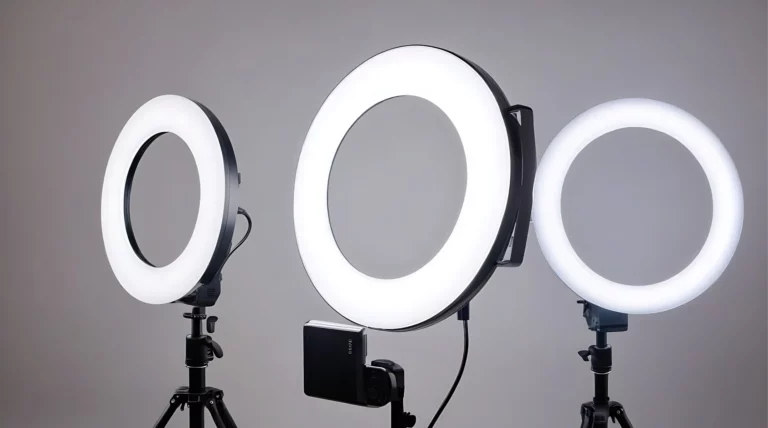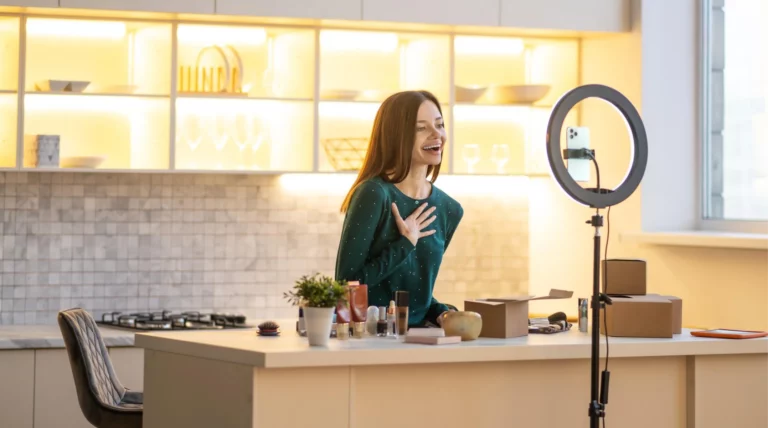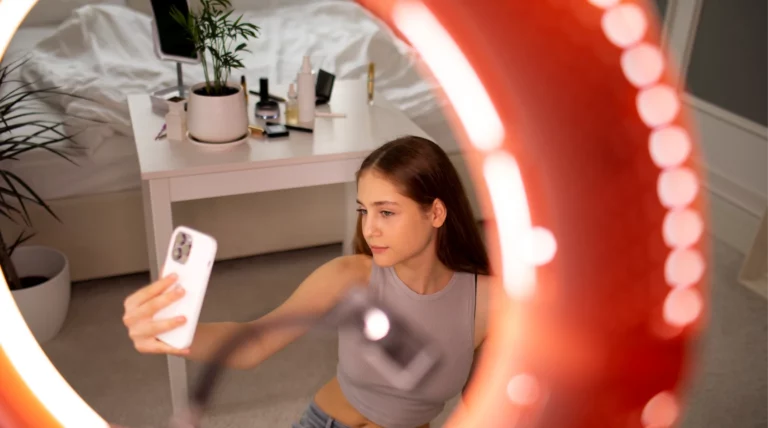Ring lights are a popular choice for product photography as they provide a soft and even light source. These lights are often used to eliminate shadows and highlight the details of the product, resulting in professional-looking images. With their adjustable brightness and temperature settings, it offer flexibility and are suitable for different products, making them an ideal lighting solution.
In this article, we have highlighted the benefits of using ring lights for product photography, how to get a professional-looking image, and also the possible disadvantages of using these lights instead of another type of lighting.
Types of ring lights

There are several types of ring lights available in the market to cater to different photography needs. Therefore, since there are so many different models, they can be split into different categories depending on what you are looking for as the main features of your ring lights.
Standard ring light
The most common type is the standard ring light, consisting of a circular LED light mounted on a stand, with a hole in the middle where the camera is going to be placed. This one is also considered a continuous ring light. It is equipped with LED bulbs and provides a constant light source that allows photographers to see the lighting effect in real-time. These types are ideal for capturing still images or shooting videos and product images, providing a consistent and even illumination.
Portable clip-on ring light
Another type is the portable clip-on ring light, which can be attached to a smartphone or a camera to provide additional lighting. These can also function as a flashlight, emitting a burst of light when taking the photograph, similar to traditional camera flashes. Flash ring lights are powerful and can freeze motion, making them sustainable for capturing fast-paced subjects or achieving a desired frame-freeze effect.
Both types of ring lights have unique advantages and are used based on the specific requirements of the photographer and the subject being photographed. There are also ring lights with adjustable color temperature and brightness settings, allowing photographers to customize the lighting based on their preferences and the specific requirements of the product.
Moreover, some ring lights have additional features like smartphone control, wireless connectivity, and the ability to mount accessories like filters or diffusers.
Also, depending on what you plan on using them for, they can be split into
- Selfies ring lights
- For professional use
- For social media images
- Food and art pictures
All in all, there are several types of ring lights to choose from. All you have to do is decide what you plan on photographing, and how you plan on doing it, and acquire the ring light best suited for your needs. If you are curious to delve deeper into this subject, you can check out this article. It details more about ring lights, how to choose them, and how to use them.
Benefits of using a ring light for product photography

Compact and easy to transport, ring lights are a good choice for product photography on a budget. They have several advantages that will help you improve your photography and make your images look professional.
One of the main advantages is the even and diffused lighting they provide. The circular shape of the ring light surrounds the camera lens and provides a balanced and even distribution of light on the subject. This minimizes harsh shadows or uneven lighting, giving product images a more professional and polished look.
Ring lights also provide a soft and flattering light that brings out the details and colors of the product. The diffused light produced by the ring light creates a pleasant, soft glow that makes the product appear more attractive and inviting. This is particularly beneficial when capturing small details, textures, or reflective surfaces, as even light highlights the subtleties and enhances the appearance of the product.
They also make additional light sources superfluous in many cases. Due to their design, they provide sufficient lighting themselves, meaning that less complex lighting systems are required. This makes them a practical and portable option, especially for product photography on location or the move.
Finally, ring lights offer great versatility in product photography. They can be used for various products, such as jewelry, cosmetics, electronics, fashion, and accessories, to name a few. Whether used for close-ups or larger products, the round shape ensures that the subject is evenly lit from all angles. This results in an even illumination of the entire product. By changing the position of the lens, you can also achieve more dramatic light and shadow effects on your product, so experiment with this often.
In summary, ring lights come with several benefits. Versatile, they provide even and diffused lighting, enhancing product details and colors while eliminating the need for additional lighting sources. These benefits make ring lights a valuable tool for photographers aiming to capture high-quality images, highlighting the best aspects of the products.
Ring lights drawbacks

Ring lights do offer some advantages for product photography, but there are also some disadvantages that you should be aware of.
Ring lights can create circular reflections or catchlights on reflective surfaces such as glass or metal objects, which can be distracting or undesirable in some cases. For example, some people find the circular light reflections created in the eyes when applying make-up unnatural or unflattering.
The uniform light produced is not always suitable for dramatic or artistic lighting effects, as it lacks the contrast and shadows that can be achieved with other lighting concepts.
Depending on the size and quality of the ring light, they can be a costly investment compared to the other lighting options available.
They can sometimes produce flat, less three-dimensional lighting. The even and diffused light they provide may not be ideal for creating depth or emphasizing textures, which can be important in certain product shots.
They may not be suitable for larger products or wide-angle shots, as their circular shape may not cover the entire subject area evenly.
Ring lights have numerous advantages for product photography, but it is important to be aware of their potential disadvantages. These include circular reflections, limited contrast and shadows, flat lighting, and limitations with larger subjects. Cost and portability are also important. While ring lights can be useful for certain product photography projects, it is important to assess their suitability for specific requirements and consider alternative lighting options if required.
How to create a professional image with ring lights

Regardless of what type of product you want to photograph, there are a few details you should keep in mind if you wish to obtain a professional-looking image while using ring lights.
Position the ring light correctly
There are two ways you can do this. The first one, is the “traditional” one, camera-in-ring-light. The second one is the professional one, by placing the camera on a separate tripod, detached from the actual ring light. Both styles are correct, but they depend on what you plan on photographing. For instance, the first way works perfectly if you want to photograph a flat-lay composition or a food plate from above. As the light is right in the middle of the product and the lens is centered, you will get even illumination. Therefore, a well-lit image.
However, the same technique shouldn’t be used if you want to emphasize a particular texture or a feature of the product. Placing the light at the same level as your shooting angle will eliminate the shadows to create contrast. Therefore, the item will look two-dimensional and flat.
To prevent this, you should use the second positioning style, more exactly, separate your camera from the ring light. Use another tripod to set your camera to prevent shakiness. Also, raise the ring lights and tilt them 45 degrees towards your product. By doing this you will achieve an even, smooth light that will show the three-dimensionality of the item.
Adjust the intensity
Most ring lights have adjustable brightness settings. Start with a moderate intensity and make adjustments based on the desired level of brightness. Avoid overexposure or extremely harsh lighting that can result in unflattering images.
Also, keep in mind that different textures reflect light differently. So, make sure to adjust the brightness according to the texture of your item so you can avoid glares or catchlights.
Modify the color temperature
If your ring light has adjustable color temperature settings, experiment with them to create the desired mood and tone for the image. For warmer tones, choose a lower Kelvin temperature. If you choose a higher one, it will produce a cooler, more daylight-like effect. Keep in mind that sunlight is the best source of light possible. So, try to emulate it as closely as possible with the ring light.
If your ring light has no adjustable temperature function, you can modify the tones by using colored diffuser disks. They can be placed in front of the light source, and they will provide the required tone and mood to your item.
Use additional lighting sources
While ring lights can provide even and diffused light, using other light sources can enhance the quality and depth of the overall product image. Consider adding softboxes to provide more directional light or using reflectors to bounce light and fill in shadows for a more balanced result. However, if you own two ring lights, you can always use them together to obtain the desired effect.
Control the distance
Adjusting the distance between the subject and the ring light can create different lighting effects. Moving the ring light closer to the item will result in a more intense and direct light. Increasing the distance will produce softer and more diffused lighting. Also, be mindful of unwanted circular catchlights on the item, and adjust accordingly. Be flexible and experiment with it to see which distance best suits your concept.
Edit and retouch
After capturing the image, use any photo editing software to fine-tune it. Adjust exposure and contrast to ensure the optimal balance of light and dark areas. Also, consider enhancing the colors, sharpness, and overall clarity of the photo. However, be cautious not to over-edit and maintain a natural and professional look. If necessary, retake the photoshoot and remedy the previous errors.
Remember, practice, experimentation, and understanding the desired outcome are key to creating professional images using ring lights. So, try different techniques and continue refining your skills.
Wrapping up
In conclusion, ring lights are a valuable tool for product photography. Their even and diffused lighting helps eliminate harsh shadows, while creating attractive-looking images. Ring lights are particularly usefor for close-up shots, providing consistent and balanced lighting to showcase product details effectively. However, it’s essential to adjust the distance and intensity of the light according to the size of the product to achieve optimal results.
FAQ
What are the main advantages of using a ring light for product photography?
Ring lights provide even and diffused lighting, eliminating harsh shadows and creating a soft, professional look. They produce circular catchlights in reflective objects, adding a pleasing and eye-catching element to product images. Also, they are useful for close-up shots, highlighting details and textures.
Can I use ring lights to photograph larger items?
Although their main use is for close-ups, they can still be used for larger products. However, remember that you have to adjust the distance and intensity of the light to ensure it remains even and balanced across the entire product.
Are there any alternatives to using a ring light for product photography?
Yes, there are several alternatives. You can use softboxes, umbrellas, or multiple light sources strategically placed to provide even lighting. You can also switch to 3D modeling and CGI rendering to make the entire process faster and stay within a budget.


























